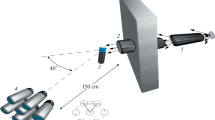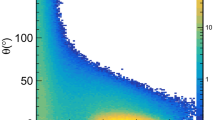Abstract
The results of the deuteron break-upd(n, nn) by 14 MeV neutrons, which show ann−n interaction in the final state, are analysed with the object of obtaining then−n interaction parameters which cannot be obtained directly.
The energy spectrum of the forward going protons in the incomplete experiments cannot easily give the scattering lengtha nn, for it is difficult to separate the effects ofa n and of the two-bodyN−N potential. When theFaddeev theory is not used, the incomplete experiments with three nucleons do not represent measurements ofa nn, but must be considered as tests of final-state interaction theories, usinga nn≈−17 fm as a parameter.
By contrast, the shape of then−n final state interaction peak in the complete experiments ought to givea nn more easily. The exact solution of theFaddeev equations gives a shape which differs little (≈ 10% atE nn≈1 MeV) from that given by the simpleMigdal-Watson relation, and which varies then little with the two-bodyN−N interaction. The valuesa nn≈−17fm obtained at hamburg (M-W relation and without correction for momentum transfer dependence), and |a nn|≧20 fm obtained at Grenoble (exactFaddeev calculations, but with theYamaguchi N−N potential) do not represent an important disagreement.
Finally, the magnitude of then−n peak in the complete experiments depends noticeably on the choice of theN−N potential; the separableN−N potential ofYamaguchi chosen for the exact calculations with theFaddeev equations gives about two times measured value at grenoble. The precise measurement of the magnitude of then−n peak together with a better choice of the two-nucleon potential (hard core, tensor forces) for the solution of theFaddeev equations, now seem necessary.
Резюме
С целью получения параметров взаимодействия, которых непосредственно нельзя получить, рассматриваются результаты развала дейтерия под действием нейтронов с энер гией 14 Мэв, в конечном состоянии которого появляется взаимодействия типаn−n.
Similar content being viewed by others
References
H. P. Noyes, Phys. Rev.,C4, 995, 1971.
H. P. Noyes, Nucl. Phys.,74, 508, 1965.
See for example:E. E. Gross, E. V. Hungerford andJ. J. Malanify, Phys. Rev.,C1, 1365, 1970.
R. Haddock as quoted inI. Slaus, J. W. Sunier, G. Thompson, J. C. Young, J. W. Verba, D. J. Margaziotis, P. Doherty andR. T. Cahill, Phys. Rev. Lett.,26, 789, 1971; but previous analysis byD. R. Nygren, Ph. D. thesis, University of Washington (1968) gavea nn=−18.43±1.53 fm.
A. B. Migdal, Zh. Eksp. Teor. Fiz.,28, 3, 1955. Sov. Phys. JETP,1, 2, 1955. The idea of studying then−n interaction from the fsi in the three-nucleon break-up was given byMigdal in 1952 in a Landau seminar presented at Moscow (Institute of Physical Problems, Acad. of Sciences). Independently,K. M. Watson, Phys. Rev.,88, 1163, 1952, suggested the fsi effect in more general reactions.
The first theoretical treatment of the three-body non-relativistic systems was given byG. V. Skornyakov andK. A. Ter-Martirosyan, Zh. Eksp. Teor. Fiz.,31, 775, 1956. The complete theoretical framework, with mathematical properties such that Fredholm theory can be applied, was given byL. D. Faddeev, Zh. Eksp. Teor. Fiz.,39, 1549, 1960 (Sov. Phys. JETP,12, 1014 1961). See also,L. D. Faddeev, Mathematical aspects of three-body problem in quantum scattering theory, Israel program for Sci. Transl. Jerusalem (1965). The multiple-scattering series summation method, equivalent to theFaddeev integral equations, was indepedently given byV. V. Komarov andA. M. Popova, Zh. Eksp. Teor. Fiz.,45, 214, 1963 (Sov. Phys. JETP,18, 15, 1964). See also,K. A. Ter-Martirosyan’s report in the Conference of Nuclear Spectroscopy, Tbilisi, 1964.
R. A. Malfliet andJ. A. Tjon, Ann. of Phys.,61, 425, 1970.
B. Akhmadkhodzaev, V. B. Belyaev, J. Wrzecionko andA. L. Zubarev, E4 — 5763 Dubna, 1971.
A. C. Phillips, Phys. Lett.,20, 50, 1966.
R. Aaron andR. D. Amado, Phys. Rev.,150, 857, 1966.
J. H. Hetherington andL. H. Schick, Phys. Rev.,137, B935, 1965.
L. M. Delves andA. C. Phillips, Rev. Mod. Phys.,41, 497, 1967.
Y. Yamaguchi, Phys. Rev.,95, 1628, 1954.
R. T. Cahill andI. H. Sloan, in three-body problem, eds J. S. C. McKee and P. M. Rolph (North Holland, Amsterdam 1970) p. 265; Phys. Lett.33B, 195, 1970.
R. T. Cahill, Ph. D. thesis, New South Wales University, 1970.
R. T. Cahill andI. H. Sloan, Nucl. Phys.,A165, 161, 1971.
C. Perrin, J. C. Gondrand, M. Durand, S. Desreumaux andR. Bouchez in three-body problem, eds J. S. C. McKee and P. M. Rolph (North Holland, Amsterdam, 1970) p. 26;J. C. Gondrand Thèse d’Etat, Université de Grenoble (1970) (Rapport CEA-R4150 [1971]);C. Perrin, Thèse d’Etat, Université de Grenoble (1971) no 7141.
R. Bouchez, S. Desreumaux, J. C. Gondrand, C. Perrin, P. Perrin andR. T. Cahill, Symposium on the Nuclear Three-body Problem, Budapest, 8–11 July 1971.
S. Shirato andN. Koori, Nucl. Phys.,A120, 387, 1968.
A. Popova, Nucl. Phys.,82, 209, 1966. This method was recently emphasized byI. J. R. Aitchison, Nucl. Phys.A148, 457, 1970.
V. K. Voitovetskii, I. L. Korsunskii andYu. F. Pazhin (Sov. Phys. JETP,17, 1612, 1964;20, 108, 1965; Nucl. Phys.,69, 513, 1965.
B. Skorodumov, G. Raduk, A. Mikulskii andYu. Talanin, Abstracts of the reports on the XXe annual meeting of the Nuclear Spectroscopy and Nuclear Structure, Leningrad, 47, 1970.
I. H. Sloan, Phys. Rev.,165, 1587, 1968.
I. H. Sloan, Phys. Rev.,185, 1361, 1969.
B. Zeitnitz, R. Maschuw andP. Suhr, Phys. Lett.,28B, 420, 1969; Nucl. Phys.,A149, 449, 1970.
H. Grassler andR. Honecker, Nucl. Phys.,A136, 446, 1969.
F. Tabakin, Phys. Rev.,174, 1208, 1968.
V. B. Belyaev, private communication.
R. T. Cahill, Unitary model for three-body collisions, preprint.
Author information
Authors and Affiliations
Rights and permissions
About this article
Cite this article
Bouchez, R. Study of the neutron—neutron interaction from the n+d break-up process. Acta Physica 33, 151–165 (1973). https://doi.org/10.1007/BF03158003
Issue Date:
DOI: https://doi.org/10.1007/BF03158003




